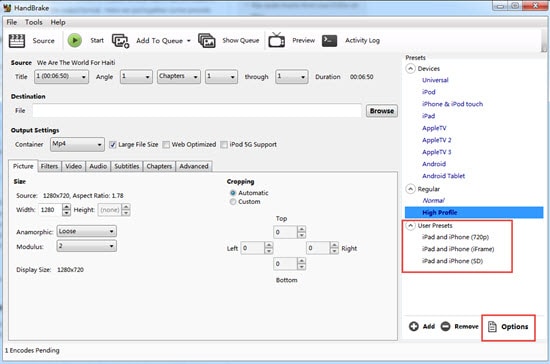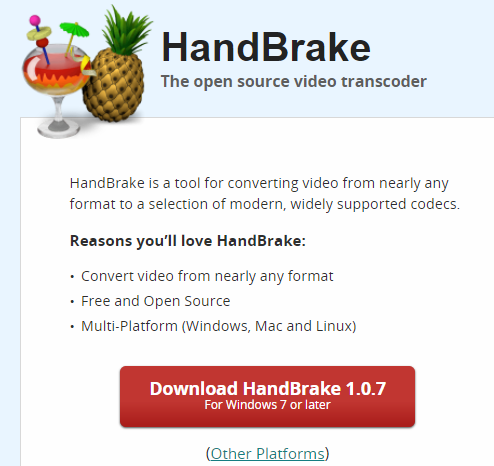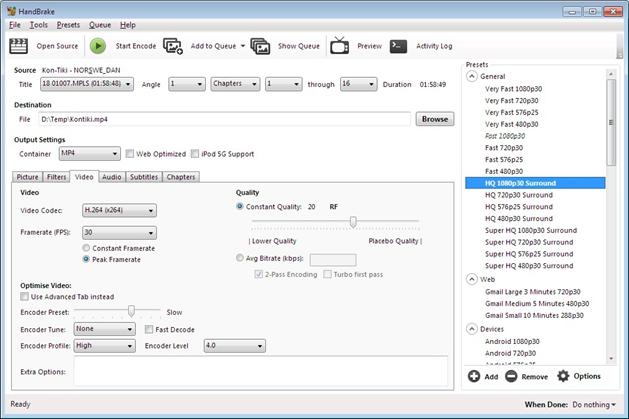

#HANDBRAKE VIDEO HOW TO#
Opening a video source How to get your videos into HandBrake.Checking for updates Staying up to date with the latest features and bug fixes.Downloading and installing HandBrake How to get HandBrake onto your computer.Where to get HandBrake The officially supported version.About HandBrake What HandBrake is, does, and does not.Quick start Learn how to make your first video in minutes.If you have any questions about using HandBrake, please ask them in the comments sections and we will see if we can help. After each iteration, see how the settings changed the final file size and the quality of the video and audio. To get the best results, it is advisable to experiment with a short video file and convert it several times with different settings. The "iPod" preset uses a lower RF value, while the "Android Tablet" preset tweaks some of the advanced H.264 parameters. For example, the "Universal" preset automatically adds a second audio track, a duplicate of the input audio but encoded in AC3 format. These are useful when you want to convert the video for a specific type of device. On the right hand side of the HandBrake window is a list of presets. Click on "Advanced" to access the controls for boosting the volume (the gain) of the resulting audio stream. "Passthru" means the audio will not be re-encoded but rather it will be sent directly into the new video file. Select the track you want to change and then alter the encoder and bitrate accordingly. Use the "Audio" tab to alter how the sound will be encoded.

The RF value for the FFmpeg encoder is more linear. This means that small changes have a dramatic impact on the quality and file size. If you are using the x264 encoder, then the RF value is logarithmic. The lower the value, the larger the file size. Changing the RF value will directly alter the file size of the encoded video. Correspondingly, the higher the value, the lower the quality of the video. The lower the RF value, the higher the quality of the video. The default value of RF:20 is good, but it can be tweaked, depending on your needs. Here you can choose which video encoder to use (either x264 or FFmpeg), and they alter the quality settings of the final video.
#HANDBRAKE VIDEO MP4#
This will tell HandBrake to optimize the MP4 file for progressive download, meaning that the file can be streamed rather than needing to be downloaded first and then played.Ĭlick on the "Video" tab to access the video encoding settings. For example, if you intend to post the video online, it is best to tick the "Web optimized" box. At this point, you can just press "Start" and the video will be converted to an MP4 file and stored in your "Videos" directory.Īlthough HandBrake's defaults are good, there are some options which you might want to check and/or change before proceeding with the video conversion. HandBrake will parse the video file and display a summary about it. To add the PPA use:Ĭlick "Source" and use the open file dialog box to find the video file you want to convert.
#HANDBRAKE VIDEO ARCHIVE#
The best way to get the software is by adding the author's Personal Package Archive (PPA) to your system and installing from there. Here is a step by step guide to converting a video file (in this case a 3GP file from a smartphone video recording) to MP4 using HandBrake on Linux.

HandBrake is designed to create MP4 files with H.264 video and AAC audio. It can actually hold several different types of MPEG encoded video, but in general, an MP4 file is expected to contain video compressed using the H.264 video codec and audio compressed using AAC, MP3 or possibly AC3. The MP4 file format is the standard container for video and audio files encoded using the MPEG-4 standards. For example, the Matroska (MKV) file format is not limited to any codec and can hold virtually anything. Some file formats can hold almost any type of video and audio regardless of how it is encoded. It in turn contains (holds) the video, audio and subtitles (if present). There is the file format itself this is known as the container. A file format like MP4 is actually made up of several components. Video file formats can be a bit confusing as there is more to a video file than just the video data.


 0 kommentar(er)
0 kommentar(er)
